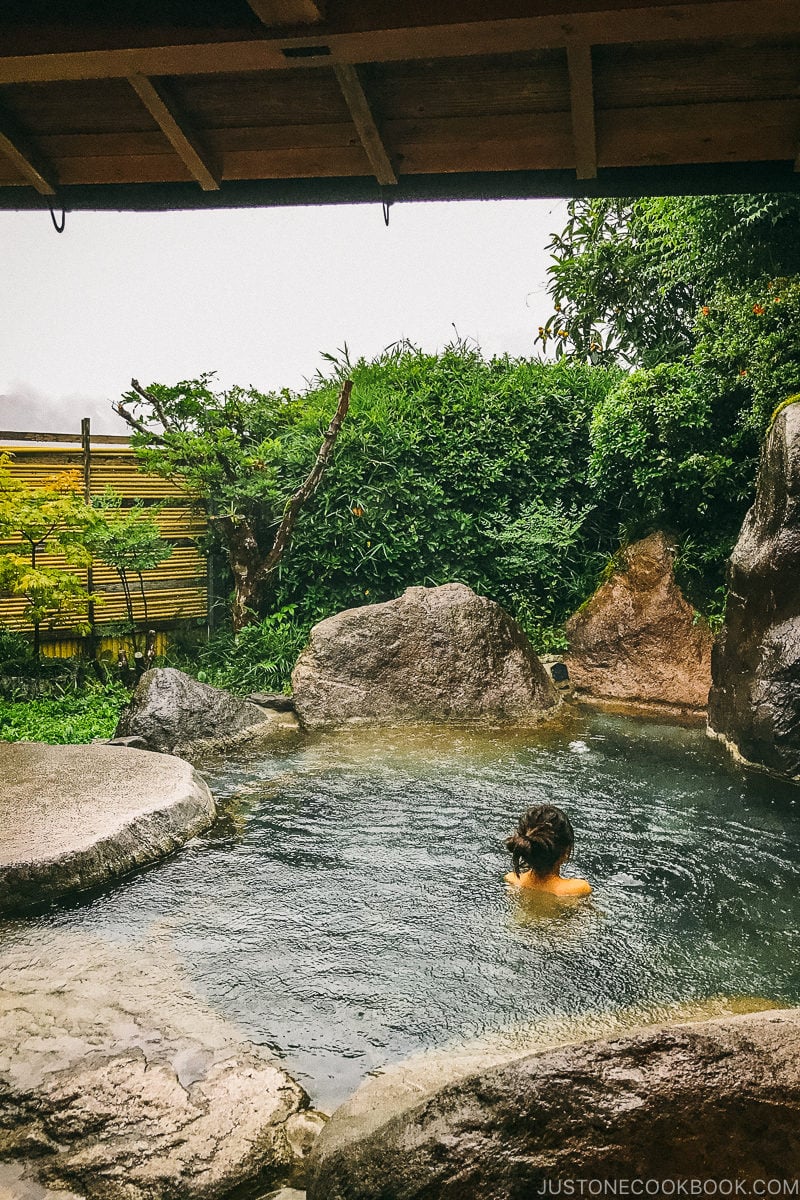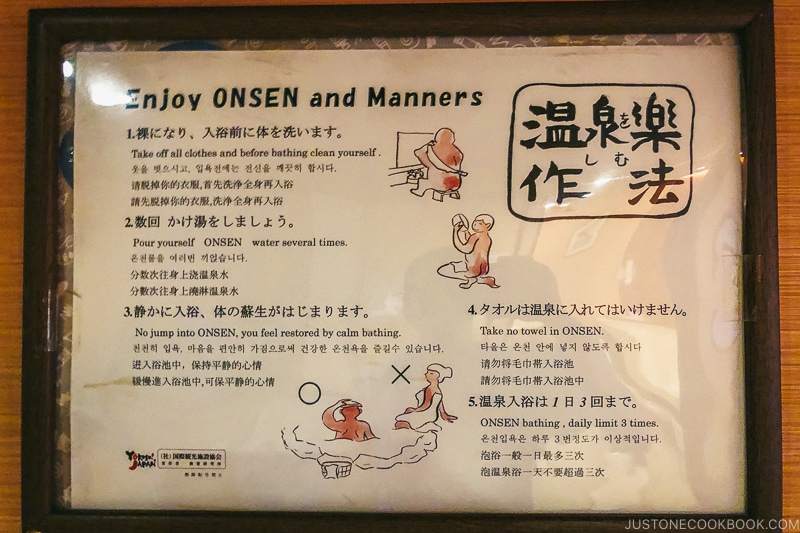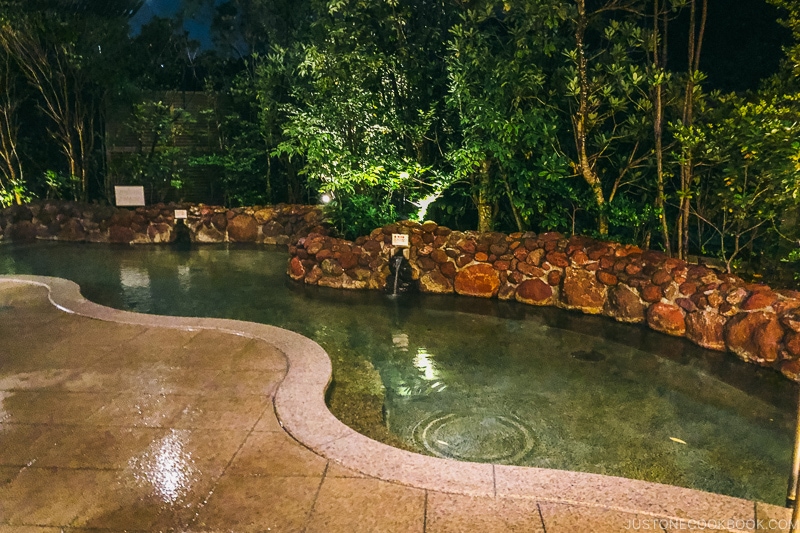
The Japanese have been seeking the medicinal properties and spiritual relaxation of soaking in onsen hot springs for centuries. Find out more about the best places to experience onsen in Japan, how to use an onsen bath and etiquettes to observe. After this, you’d be ready for a memorable onsen experience on your next trip to Japan!

Onsen (温泉) are Japanese hot springs. While hot springs can be found wherever volcanic activity is rampant, the Japanese have had a special affinity for the mineral waters. Onsens are plentiful across the country, and most located outside the city limits, which are accessible by train or car, making a weekend getaway affordable.

While the practice of bathing in a hot spring can be found outside of Japan, the process of healing the mind and body through bathing is an integral part of Japanese culture. Like in the scene in the Miyazaki film “Spirited Away,” soaking in an Onsen is enjoyed by the young and old (and spiritual deities too!) It makes appearances in the ancient Japanese texts Kojiki (古事記) and Manyoshu (万葉集) and is central to the Shinto (Japanese indigenous religion) ritual purification of “Misogi” (禊), the hand and mouth purification of “Chozuya” (手水舎), and the Buddhist bathhouse sutra of “Onshitsukyo” (温室経).
![Yosemite [CC BY-SA 3.0 (http://creativecommons.org/licenses/by-sa/3.0/)]](https://www.justonecookbook.com/wp-content/uploads/2019/10/Your-Guide-to-Japanese-Hot-Springs-1-Jigokudani_hotspring_in_Nagano_Japan_001.jpg)
Here’s what you need to know before taking an Onsen bath in Japan! We’ve also answered all the questions you may have so you can enjoy this Japanese tradition with ease.
What is an Onsen?
Onsen (温泉), literally “thermal spring”, is geothermally heated water. The spring water naturally contains minerals and chemicals which are said to cure all sorts of diseases and ailments. The hot spring facilities boast the benefits of the waters, and onsen seekers travel great distances for these benefits for centuries, even today.

In Japan, Onsens are heavily regulated by the Onsen Law, enacted in 1948 by the Japanese Ministry of the Environment. This law requires the identification of 19 different minerals and chemicals, the spring water to be 25 degrees Celsius or above, and to contain certain levels of hydrogen ion, fluorine ion, sulfur and the like. The ministry officially recognizes 2,300 onsens across the country, but many more natural and untouched springs exist.
Some are stand-alone facilities, some are in ryokan (Japanese inns). The price can range from the high end to the low, and can also fluctuate with tourist season. You do not necessarily need to stay at an Onsen ryokan to experience it; some allow day use for non-guests and many Onsen areas offer passes to multiple Onsen facilities, so you can Onsen hop!


There are non-Onsen baths called Sento (銭湯), which are affordable and accessible. While also communal baths, it is usually just heated water and is for daily use. If you’re strolling around a residential area, you may spot a sign with the Chinese character “湯” (hot water) or the Hiragana “ゆ”. Feel free to casually drop in for a bath and eye-opening experience!
Where Can I Experience the Best Onsen in Japan?
With so many different styles and varieties of Onsen, where should you start? Here the best regions you can experience in Japan. Should you be traveling nearby, definitely take a day or two to stopover.
1. Noboribetsu Onsen (登別温泉), Hokkaido prefecture
Meaning “Milky White River” in the Ainu language (an indigenous people of Hokkaido, the Kuril Islands, and Sakhalin), the area of Noboribetsu Onsen was first discovered and frequented by the Ainu for its healing properties. It’s also referred to as the department store of the hot springs, as you can find seven different types of minerals, and therefore seven different types of hot springs.
2. Kusatsu Onsen (草津温泉), Gunma prefecture
A 3-4 hour bus or train ride north of Tokyo, the lively town of Kusatsu is famous for its sulphuric waters and free-flowing hot springs. When visiting, you must check out the impressive Yubatake (湯畑) to see 4,000 liters of hot water and steam gushing out of this one source per minute, where the spring water flows through and into the nearby Onsen facilities.
3. Atami Onsen (熱海温泉), Shizuoka prefecture
Located just 35 minutes away on the bullet train from Tokyo, Atami Onsen makes an ideal day trip from Tokyo. The scenic ocean resort of Atami has been catering weary bodies for over 1,000 years. Loyal patrons include the first Edo shogunate Tokugawa Ieyasu, who is said to take casks of the spring water back to Edo (now Tokyo). The waters are famous for its sulfate and salt-rich properties.
4. Gero Onsen (下呂温泉), Gifu prefecture
Just an hour away from Hida Takayama and Nagoya, the hot springs of Gero Onsen are colorless alkaline-based. The springs are also nicknamed the “beauty hot springs” and are said to improve the skin. The minerals are mild, so it’s perfect for first-timers or those with sensitive skin. There are free Onsen facilities around town, one that is mix gender AND open-air, right in the center city under a bridge! You can dip your toes into Fusenchi (噴泉池), or for the more adventurous, change into a bathing suit and jump in.
5. Arima Onsen (有馬温泉), Hyogo prefecture
Squeezed between a mountainous region, but an easy getaway for Osaka and Kobe residents, it is one of the most famous and prestigious Onsen region in the country. Here, you’ll find two types of hot springs: Kinsen “gold water” (金泉) has a reddish-brown hue due to its high iron content and is said to be good for hypersensitivity, skin ailments, and muscle pain. The translucent Ginsen “silver water” (銀泉) contains radium and carbonate and is said to cure various muscle and joint ailments.

Read more about the JOC family’s stay at Arima Onsen.
6. Beppu Onsen (別府温泉), Oita prefecture
Located in southern Japan just 2 hours from Fukuoka, Beppu Onsen boasts the highest concentration of hot spring sources and the highest yield of hot spring water in Japan. Walking around this quaint town, you’ll see thick clouds of steam rising from drains and air vents. Take a tour of the eight “Blood Pond Hells” (血の池地獄), frightful natural ponds gushing out 100 degrees Celsius fumarolic gas and thermal mud, resulting in a hair raising blood-red or cobalt blue water and hot steam.

Read more about the JOC family’s stay at Beppu Onsen.
There are many that couldn’t fit in this article and more hidden gems scattered across the country. For hotels and Onsen resorts, I suggest exploring TripAdvisor or Japan-Guide to start; part of the fun of traveling is the planning! With the 2020 Summer Olympics as well as the exponential growth of travelers from abroad, Onsens and the tourism industry is constantly building and renovating to accommodate the demand. Thus, it’s hard to recommend a handful of Onsen ryokan, so hope your search is fruitful!
Curious where the JOC family has bathed? Read more about their Onsen experience around Japan here.
Are there Onsens in Tokyo?
If you’re visiting Tokyo but don’t have time to take a detour to an Onsen, why not spend an afternoon in an urban oasis?
Ooedo-Onsen Monogatari (大江戸温泉物語)
Like an indoor amusement park in a traditional Japanese summer festival setting, you can easily spend an entire day soaking in the many baths and checking out the activities within the facility. At the entrance, you first change into a Yukata (cotton traditional Japanese robe) and can stroll around munching on Japanese snacks or play Japanese carnival games. It’s also family-friendly as well! It’s conveniently located in Odaiba, and the facility offers free shuttles to major train stations.

Treat yourself to this luxurious spa and Onsen facility after a long day of walking and sight seeing. Located in Tokyo Dome City, Spa LaQua is more catered towards an adult crowd, (entry is for children 5 and up), but it’s perfect for those seeking peace and tranquility. For an additional fee, they offer massages, pedi/manicures, as well as facial and body treatments.

A recent newcomer to the Tokyo Onsen scene, it’s located right smack in the center city of Shinjuku. Offering a spectacular city scenery from the Onsen and the rooms, the hot spring waters are brought over from Hakone, a popular hot spring area in Kanagawa. They do not offer day use of the Onsen, so you must stay here to use their facilities.
How to Use an Onsen Bath
Ready to hop in? Here’s your step-by-step guide on how to use an Onsen in Japan:

The Changing Room
- Remove all articles of clothing, jewelry, and accessories (wedding rings are okay)
- Put clothing in the provided basket or lockers
- Stowaway valuables such as keys, phones, cameras, or wallets in the security box (may be located at the onsen entrance)
- Remove makeup at the sink. Some places may offer makeup remover or wet wipes
- Bring a small towel (optional), hair tie (for those with long hair)






The Washing Area
- Cover yourself with the small towel when entering (optional)
- Pick a washing station
- Sit down on the stool provided
- Thoroughly wash and scrub your body, face, and hair (optional)
- Feel free to use the shampoo and soap provided, or bring your own
- After use, tidy your station and return the stool, bucket, and showerhead to their original locations
- Tie up long hair into a bun or a high ponytail so it won’t touch the water


The Onsen
- Fold the towel and place on top of your head, wrap around your head, or place on the side of the bath where it won’t get wet
- Be respectful of other fellow bathers, do not stare and give adequate space in between
- No running, swimming, splashing or scrubbing yourself in the baths
- Do not let your hair touch the water
- If there are different types of baths in the facility, feel feel to roam around, no need to shower in between. Some may be set to different temperatures, some may have herbs and fragrances infused in the water or have special effects
- Soak in the hot water and relax!





Exiting the Onsen
- Give yourself a quick wash down at the washing area, and make sure to clean up after yourself
- Dry off well with the small towel at the entrance before walking over to your locker to change
- Feel free to use the hairdryer, lotions, and creams provided. Don’t forget to clean up after yourself
- After changing and leaving the changing room, relax in the public space and don’t forget to hydrate! There should be vending machines, water fountains, and tea dispensers for you to quench your thirst



Onsen Etiquettes & Rules
Since Onsen is a communal experience in Japan, there are some rules of etiquette you will have to observe:
Q: I have tattoos! Can I use Onsen?
This is probably the most asked question from foreigners when comes to using an Onsen in Japan! The reason why tattoos are not allowed in Onsen is that tattooed people have been traditionally linked to the Japanese underground society. By banning tattooed patrons, the Onsen facilities are able to shun these bathers. It is not a disregard of the craft.
The good news is the Japanese society has incrementally loosened its tattoo ban to accommodate the influx of foreign tattooed tourists in recent years. However, some that may still continue the policy.
My advice is to check the website or call beforehand to ask about their tattoo policy. If your tattoo is small, cover it up with a bandaid. You can also choose to stay at a Japanese inn with a private Onsen attached to your room. Or find a place where you can rent out an Onsen for yourself.

Q: What is the small towel used for and is it necessary?
The small towel that may be given to you or available for purchase is for two purposes, a washcloth and also to used to cover up your private areas when entering and exiting the Onsen. The towel is not necessary, but more for modesty use. If you stay at a ryokan, most ryokans expect guests to keep the small towel and bring back to their room to dry.

Q: Can I still use the Onsen if I have an injury/sickness/medical condition?
If your injury is an exposed wound that may become infected or contaminate the waters, you must avoid the Onsen. If you have a medical condition or is feeling under the weather, ask your healthcare provider in advance. The water temperature can be hotter than you expect, so don’t take the risk!
Q: Can I use Onsen when pregnant or when menstruating?
Similar to the above, ask your healthcare provider in advance. If you are menstruating, avoid the Onsen even if you have a tampon/menstrual cup on.
Q: Can I bring small children of the opposite gender?
It could be a scary feat for small children to bathe alone without a familiar face in sight! Some places may explicitly state the criteria of bringing children of the opposite gender (e.g. under xx cm/xx age). You could always opt for staying at a Japanese inn with an Onsen attached or rent out a private Onsen for the whole family to enjoy.
Q: Do I really have to strip down naked? Can I wear a bathing suit?
Unfortunately, yes. You must remove all articles of your clothing before entering. If you’re shy of getting down to your birthday suit, opt for staying or renting out a private Onsen.
There are two exceptions for covering up. First, if you enter a Konyoku 混浴, mixed-gender Onsen. In this case, you are allowed to fully wrap yourself with a bath towel. The other condition is if you soak in a river with natural hot spring water, which entails bathing in the outdoor wilderness.

Q: I’d like to take photos of the Onsen/myself bathing. Can I bring my camera?
Absolutely not! Even if you vow not to take pictures of other bathers, this is a privacy infringement and will get you into serious trouble if caught. If you insist on taking photos, opt for staying or renting out an Onsen for your private enjoyment.

Q: What should I bring?
Many facilities offer towels and provide shampoo/soap. If not, they are most likely be available for purchase at the entrance. Hairdryers and face lotions are most likely provided as well. You can just bring a change of clothes, so no need to come prepared! If you’re staying at a Japanese inn with an Onsen, you can change into the Yukata (cotton Japanese robes) provided in your room, or come in normal clothes.

Q: What other things should I avoid before entering an Onsen?
You should avoid going immediately after a meal, drinking alcohol, or after an intense workout. The hot water will raise your body temperature and stimulate blood flow, so give yourself adequate time to settle down before dipping in. The floors can be slippery, so you should always be cautious and never run.
Lastly, don’t forget…
Japanese Onsen is a truly unique experience for any visitors to Japan. While all these etiquette rules can be overwhelming, I hope this has convinced you to take a dip and immerse yourself in this invigorating custom. Just remember to be courteous and mindful of others, and also listen to your body and take breaks in between to avoid overheating. After all, an Onsen is a shared space where bathers come to relax and indulge!

Have you taken an Onsen bath in Japan? Will you give Onsen a try? Share your Onsen stories and recommendations in the comment box below!
from Merah Hati Cintaku https://ift.tt/2AUsSTk
via MerahHatiCintaku.blogspot.com